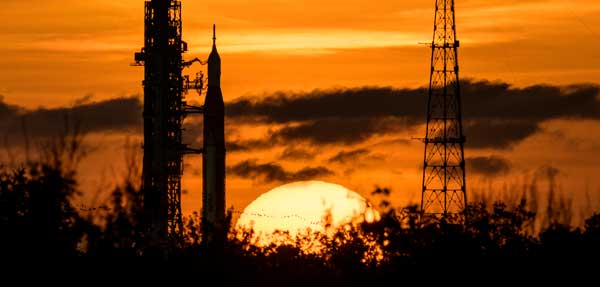
KENNEDY SPACE CENTER, Fla. (NASA PR) — After disconnecting the ground and rocket-side plates on the interface, called a quick disconnect, for the liquid hydrogen fuel feed line, teams have replaced the seals on the Space Launch System rocket’s core stage associated with the liquid hydrogen leak detected during the Artemis I launch attempt Sept. 3.
Both the 8-inch line used to fill and drain liquid hydrogen from the core stage and the 4-inch bleed line used to redirect some of the propellant during tanking operations were removed and replaced this week.
Coming up, technicians will reconnect the umbilical plates and perform inspections over the weekend before preparing for a tanking demonstration as soon as Saturday, Sept. 17. This demonstration will allow engineers to check the new seals under cryogenic, or supercold, conditions as expected on launch day and before proceeding to the next launch attempt.
During the operation, teams will practice loading liquid hydrogen and liquid oxygen in the rocket’s core stage and interim cryogenic propulsion stage and getting to a stable replenish state for both propellants. Teams will confirm the leak has been repaired and also perform the kick-start bleed test and a pre-pressurization test, which will validate the ground and flight hardware and software systems can perform the necessary functions required to thermally condition the engines for flight. Following the test, teams will evaluate the data along with plans for the next launch opportunity.
NASA has submitted a request to the Eastern Range for an extension of the current testing requirement for the flight termination system. NASA is respecting the range’s processes for review of the request, and the agency continues to provide detailed information to support a range decision.
In the meantime, NASA is instructing the Artemis team to move forward with all preparations required for testing, followed by launch, including preparations to ensure adequate supplies of propellants and gases used in tanking operations, as well as flight operations planning for the mission. NASA has requested the following launch opportunities:
- Sept 23: Two-hour launch window opens at 6:47 a.m. EDT; landing on Oct. 18
- Sept. 27: 70-minute launch window opens at 11:37 a.m.; landing on Nov. 5
NASA’s teams internally are preparing to support additional dates in the event flexibility is required. The agency will evaluate and adjust launch opportunities and alternate dates based on progress at the pad and to align with other planned activities, including DART’s planned impact with an asteroid, the west coast launch of a government payload, and the launch of Crew-5 to the International Space Station.

